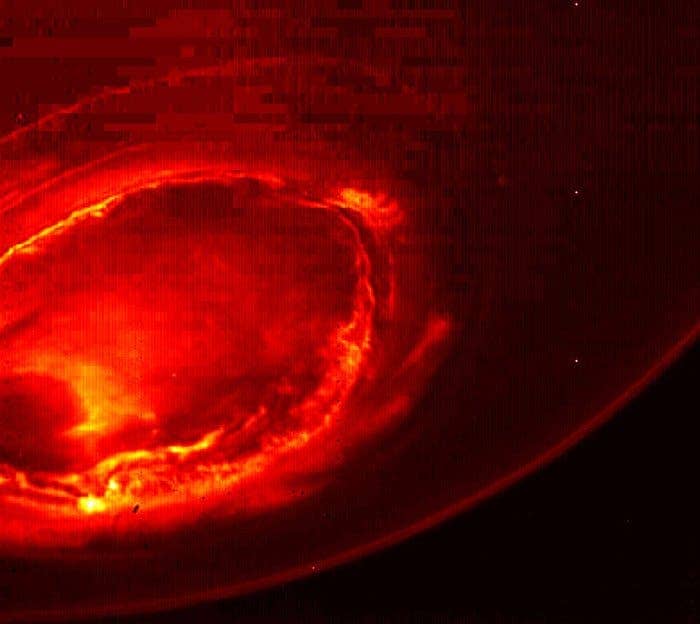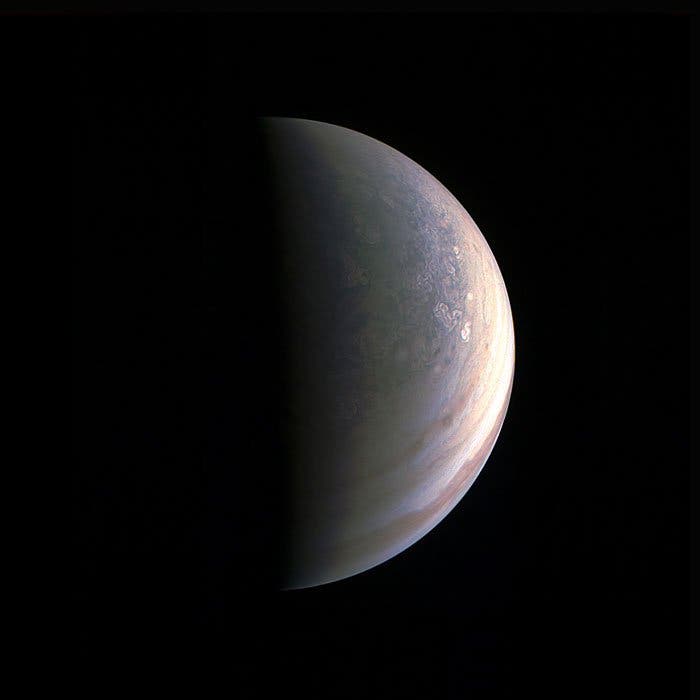NASA has just shared the data from Juno’s flyby of Jupiter last week, containing the most detailed images of the gas giant that humans have ever seen. The new information surprised even the specialists who didn’t expect how unique the largest planet in the Solar System would prove to be up-close.

Image credits NASA / JPL-Caltech.
Following a five-year journey through space, the Juno probe entered Jupiter’s orbit in July. Last week, it got closer to the planet than any other spacecraft in history and managed to take some breathtaking snaps of the giant. It took NASA one and a half days to download the treasure trove of images from this historical six-hour flyby. The pictures revealed previously unseen storm and weather systems, and Jupiter’s never-before-seen north pole.
“[We got our] first glimpse of Jupiter’s north pole, and it looks like nothing we have seen or imagined before,” says principal investigator of the Juno mission Scott Bolton, from the Southwest Research Institute in San Antonio.
“It’s bluer in colour up there than other parts of the planet, and there are a lot of storms.”
Far from the orderly striped appearance of Jupiter’s midsection, the north pole is a swirling mass of roiling hurricane-like storms.

Image credits NASA / JPL-Caltech.
“There is no sign of the latitudinal bands or zone and belts that we are used to – this image is hardly recognisable as Jupiter,” says Bolton. “We’re seeing signs that the clouds have shadows, possibly indicating that the clouds are at a higher altitude than other features.”
One thing scientists expected to see but didn’t is a hexagonal formation over the north pole, a structure which other Solar System gas giants — such as Saturn — have.
“Saturn has a hexagon at the north pole,” says Bolton. “There is nothing on Jupiter that anywhere near resembles that. The largest planet in our Solar System is truly unique.”
Along with the images of the north pole, the Juno team used an infrared device – the Italian Space Agency’s Jovian Infrared Auroral Mapper (JIRAM) – to analyse Jupiter’s polar regions in infrared wavelengths. This revealed warm and hot spots all over the giant’s polar regions and also gave us our first glimpse of the planet’s southern aurora.
“JIRAM is getting under Jupiter’s skin, giving us our first infrared close-ups of the planet,” says researcher Alberto Adriani from the Istituto di Astrofisica e Planetologia Spaziali in Rome. “And while we knew that the first ever infrared views of Jupiter’s south pole could reveal the planet’s southern aurora, we were amazed to see it for the first time.”
During the flyby, Juno passed about 4,200 kilometres (2,600 miles) above Jupiter’s clouds and it activated all eight of its onboard data collection instruments. One of these, the Radio/Plasma Wave Experiment instrument (Waves), recorded radio emissions thought to be produced by Jupiter’s auroras.
By converting these signals into an audio frequency, NASA put together a recording of the rest of Jupiter’s “voice” — and it will make the hairs stand on the back of your head.
“Jupiter is talking to us in a way only gas-giant worlds can,” says Waves co-investigator Bill Kurth from the University of Iowa.
“Waves detected the signature emissions of the energetic particles that generate the massive auroras which encircle Jupiter’s north pole. These emissions are the strongest in the Solar System. Now we are going to try to figure out where the electrons come from that are generating them.”
NASA researchers have only now begun analysing the data from the probe’s first sweep of the planet, but with 35 more orbital flybys yet to come, one thing’s for sure: Juno’s only just started spilling Jupiter’s secrets.
“It’s going to be a flood,” Juno project scientist Steve Levin from NASA’s Jet Propulsion Laboratory told Amina Khan at the Los Angeles Times. “Like drinking from a fire hose.”


